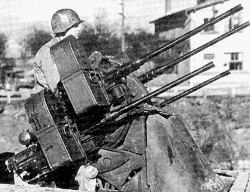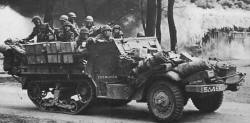A Brief History
M3 Troop Carrier (M16 version)
The Carrier, Personnel Half-track M3
was an armored vehicle used by the
United States, the British Empire
and the other Allies during World
War II. Nearly 43,000 were produced,
and supplied to the U.S. Army and
Marines, as well as British
Commonwealth and Soviet Red Army
forces, serving on all fronts
throughout the war. Forerunner of
the modern infantry fighting
vehicle, the M3 Half-Track was of
half-French origin. In 1931 the U.S.
Army purchased a French Citroen-Kegresse
Model P17 half-track as part of a
research and development effort for
its own design. Working with private
firms, the Army Ordnance Department
produced the T14 prototype in 1939.
In September of the following year
the T14 was standardized and
accepted for production; it became
the M2 and the M3 Armored Personnel
Carrier.
Total production of the M3 ran to
nearly 41,000 vehicles.
The M3 was the larger counterpart to
the M2 Half Track Car. Ten seats
were arranged down either side of
the vehicle, with three in the cab.
Racks under the seats were used for
ammunition and rations; additional
racks behind the seat backs held the
squad's rifles and other stowage. A
small rack for mines was added on
the outside of the hull just above
the tracks. In combat, most units
found it necessary to stow
additional food, rucksacks and other
crew stowage on the outside of the
vehicle. Luggage racks were often
added in the field, and very late
vehicles had rear-mounted racks for
this crew stowage.
The M16 is the anti-aircraft version
of the M3 troop carrier.
The basis of the half-track was a
truck chassis and drive train. An
armored box was placed in the back
to provide protection for personnel
and armament. This vehicle was
equipped with a ditch roll which
helped in traversing obstacles. Some
vehicles were equipped with a winch
in place of the ditch roll. Radiator
louvers were used during battles to
protect the radiator from small arms
fire. The 4 speed transmission,
combined with a 2 speed transfer
case yielded 8 speeds forward with
two in reverse. The levers to the
right of the shift lever select high
and low range and front wheel drive.
The center seat is the jump seat,
usually for the gunner. The track is
constructed of two steel cables with
rubber track molded around them. The
rubber gives flexibility to the
track while the cables are for
reinforcement. The rear idler is
used to adjust track tension. The
power plant is a White 160 AX, 6
cylinder engine.
The U.S. half-track was first used
in the Philippines where several
initial design problems arose. The
suspension was modified for
increased reliability, but one of
the main criticisms, the lack of
overhead armor, was never changed
throughout the life of the vehicle
since the added weight decreased
mobility. In North Africa the
half-track was improved with heavier
road wheel springs and heavier
springs for the rear idler. At the
time of the invasion of Sicily, the
half-track had settled into its role
as an armored infantry transport
vehicle that was able to deliver
infantry closer to the battle since
they were less vulnerable to rifle
fire. The vehicle would hold
supplies and infantry field
equipment, leaving the infantry
unencumbered by heavy field packs.
The half-track was highly mobile and
could follow tanks quite easily,
unlike trucks which were more at
home on the road. The half-track was
often criticized as too lightly
armored, but this could partially be
attributed to abuse of the vehicle.
Some units used the half-track as an
armored assault vehicle which was
not its role by design.
|

Soldier manning the Browning .50
Caliber Machine Gun turret

In combat, one would fire while the
other two reloaded the magazines

In the mud of the French battlefield

Troop Carrier Variant |






